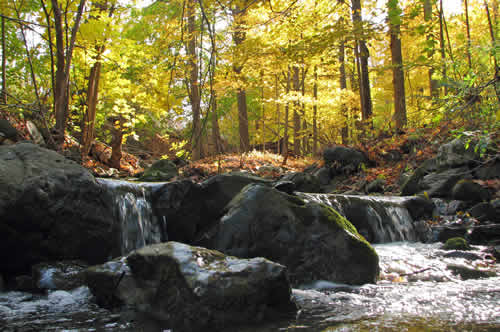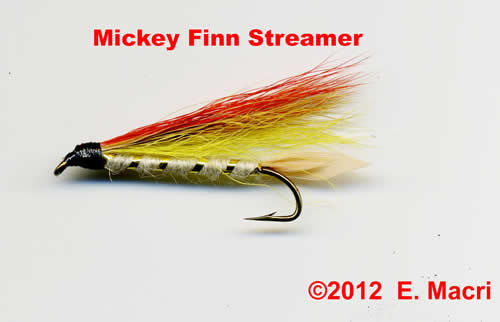Stream Restoration
by
Eugene P. Macri Jr.

Stream restoration projects in America have become big business. The
EPA, Forest Service and other federal agencies have jumped on the bandwagon. State agencies, fishing clubs
including Trout Unlimited and so called environmental policy groups have also fallen for this pseudoscientific
stream manipulation. The price of these projects is enormous for even a small
stretch of water. The results are anything but flattering as one movie producer put it! Frissel and Nawa
(1992) evaluated 161 of these projects in western Oregon and Washington. Over 18% failed and 60% were
ineffective or damaged (Kondolf and Micheli, 1995).
The latest "so called expert" is Dave Rosgen of Wildland Hydrology
Consultants in Colorado. Dr. Rosgen is a devotee of the late Luna Leopold whose book
Fluvial Processes in Geomorphology is the book I used in graduate school in Environmental Engineering. Rosgen offers courses,
some on the weekend to engineers, consultants, engineering firms and others who believe in his magic engineering
methods.
No matter what Rosgen says he and Leopold have the same basic
theory: Water Should Move! Therefore, the engineering design of most of Rosgen's work is to turn everything
into a "Western River." All of the so called restored projects using his methods for the most part look
amazingly the same! This engineering myth is often called the "The Field of Dreams Myth." It stems from the
idea that if you build a particular physical structure for a designed ecosystem the biological components of the
system will magically come together or self-assemble, in other words: "If you build it, they will come!"
(Hildebrand, Watts and Randle, 2005)
All of these are part of the "Restoration Mythology" that is so
prevalent in the United States where they believe anything can be modeled. This is a product of the "Carbon
Copy Myth" which is employed by Rosgen and those who follow his thesis. Rosgen's courses and books teach that by
studying his categories of stream types the engineers can create geomorphic stream channels which will produce
certain results for any particular water. This "cookbook" approach fails to understand the limitations of
methodology and is lacking in proper studies to show that any of it is valid. (Hildebrand, Watts and Randle,
2005).
In fact, a Harvard Study by Juracek and
Fitzpatrick concluded that Rosgen's Stream Classifications were
only good for descriptions and communications among scientists and not appropriate for how they are being
used. The entire concept of channel understanding by Rosgen and his devotees is of limited
usefulness. Why? Because the channel analysis as described by Rosgen is really very
temporal and is like a fuzzy photograph that does not represent the real world in terms of the processes that
are going on. They do not show the history of such events in my evaluation. It is a very static
model. Rosgen's models show a lack of understanding of processes in terms of their time
span, frequency, and magnitude.
An analysis of Rosgen's Methods by Roper et all in 2008 showed
extreme inconsistency in the engineers' s ability to accurately agree on the classification of streams! If
engineers can't accurately even pick the right classification what do you think the results will be when they apply
their methods to the streams! Dr. Kondolf of UC Berkley College of Environmental Design has given numerous
presentations and lectures on Rosgen's failures and lack of knowledge in geomorphology.
The question that is seldom posed by those who decide to use these methods of
stream manipulation: What are we suppose to accomplish by this stream "restoration?" Is this for
flood control, changing erosional capabilities of the stream, restoring some type of habitat, or to make the stream
look pretty? Contrary to what the EPA, Forest Service, and other groups say you can't do all of these and
there is no inclusion of the biological conditions including macrophytes, fish populations and
the macroinvertebrate community. Thus full filling "The Field of Dream Myth" of build it and they will
come!
I have studied many of these restoration projects in great detail. In almost every instance I have seen two things: the
homogenization of current speeds and substrates. This obviously
destroys the biodiversity of the macroinvertebrate community! On some stream restoration projects such as Big
Spring the substrates were actually destroyed wiping out massive mayfly populations (in this case Ephemerella
invaria, the Sulfur). In some of these projects fish habitat was changed with damage to native
species. But their is a real kicker to all of this. I have friends of who work for these engineering
firms. What they have told me is this: "I don' think we really know what we are doing!" They are
told by the company just do it. Don't ask questions. No one will really know is what we've done! Most of these
projects all look the same.....a pretty little S Curve.
I rest my case. Some stream restoration projects work, some don't and most are
waste of time and money and in many instances do more damage than good. Most
projects including the macroinvertebrate community are never properly evaluated to see what happens in a few
years. In my opinion when they
do work, they work best on
small freestone streams not subject to massive flood potential.
Furthermore, they are extremely damaging to spring creeks because the "restoration turns out to be an attempt to
make these streams into freestone streams." I would never let any of these groups work on a spring creek.
There is a reason that the English River keepers don't put much permanent structure in their streams, too bad The
Field of Dream Engineers of America haven't figured out why!

| 
